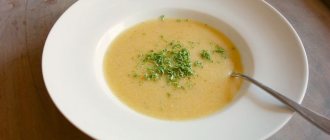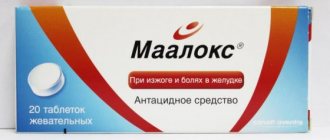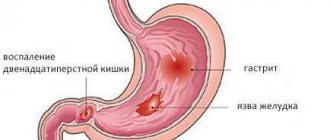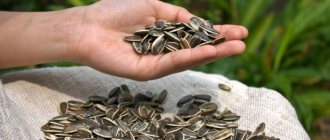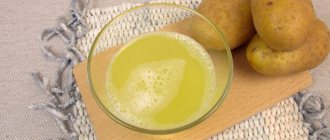Chemical composition and calorie content
Vegetables contain many minerals that have a general strengthening effect on the body. The high potassium content helps remove excess fluid from the body, strengthening the cardiovascular system and muscles. Calcium and iron salts are needed for the formation of bone tissue. Phosphorus and sodium help normalize blood pressure and regulate water metabolism. Magnesium strengthens the nervous system and improves myocardial performance.
Did you know? Cabbage is a negative calorie food - this means that the human body spends more energy digesting the vegetable than it receives from eating it.
Is it possible to eat sauerkraut if you have a stomach ulcer?
Sauerkraut is beneficial due to its large amount of vitamin U, which is a great preventative against the formation of ulcers. The lack of this vitamin contributes to the thinning of the walls of the mucous membrane of the stomach and an increased risk of the formation of lesions.
The use of sauerkraut is allowed only in a healthy state, when there are no erosions or adhesions on the walls of the stomach. Then the pickled vegetable will not only help restore the body’s properties, but also improve the motility of the stomach and intestines.
In the stage of subsiding of the pathology, sauerkraut juice is also useful, which, due to its properties, is more easily absorbed by the body, carries the rapid absorption of the vitamin into the bloodstream and enhances the effect of the patient’s immune system, eliminating bacteria and pathological agents.
The preventive properties of sauerkraut are irreplaceable in the body, so in a healthy state this vegetable must be eaten regularly.
The special value of cabbage prepared by pickling is its pronounced preventive effect.
- Sauerkraut juice is rich in vitamin U, which is a powerful anti-ulcer agent.
- With a deficiency of this component, the body becomes prone to the formation of erosive and ulcerative formations on the mucous membranes of the digestive system.
- But in case of acute gastric ulcer, eating sauerkraut is strictly unacceptable.
- Only after the exacerbation has resolved and in the absence of signs of hyperacidity can you take freshly squeezed cabbage juice, which is recommended to be consumed half a glass before meals.
Such a freshly squeezed drink will help improve gastrointestinal activity, create favorable conditions for the development of beneficial gastrointestinal microorganisms, and also inhibit the development of pathogens.
Doctors recommend including cabbage of different varieties in the diet of patients. It is unique in its action, it can speed up recovery, but also provoke an exacerbation.
Cabbage for stomach ulcers helps heal wounds and reduce inflammation. The juice has medicinal properties. It is fiber-free and high in S-methylmethionine. Sauerkraut for gastritis increases acidity, relieves inflammation, and improves the functioning of the organ.
Experts say that sauerkraut for stomach ulcers should be included in the diet and eaten every day during the period of remission. It contains vitamin U, better known as S-methylmethionine, with powerful effects:
- Antibacterial.
- Anti-inflammatory.
- Wound healing.
- Antitumor.
The disadvantage of all types of cabbage is its high fiber content. This is beneficial for a healthy body. But if the disease affects the organs of the gastrointestinal tract - the gastrointestinal tract, then coarse fiber irritates the inflamed mucous membrane and provokes an exacerbation.
Juice squeezed from fresh and sauerkraut contains all useful substances except fiber. It is used during treatment as an adjuvant. Studies have shown that when drinking half a glass of the drink 3 times a day, the patient recovers faster. For gastritis with low acidity, press sauerkraut. To treat stomach ulcers, use the juice of fresh white cabbage leaves.
Attention! During the initial period of exacerbation of the disease, cabbage and juice should not be consumed. You can start drinking juice and include sauerkraut in your diet with your doctor’s permission. An individual diet is selected for each patient.
Stomach disease occurs for various reasons. When prescribing a diet, the characteristics of the patient’s body are also taken into account. The doctor decides on a case-by-case basis what to treat and what foods to eat.
Sauerkraut for gastritis and duodenal ulcers
Sauerkraut juice is used in folk medicine to treat stomach problems and poor appetite. It should be borne in mind that it not only heals wounds, relieves inflammation and improves motor skills. Juice may cause gas and acidity. Cabbage is a unique vegetable. Pickled it contains more vitamins than fresh. The juice contains a whole range of microelements:
- Magnesium.
- Iron.
- Zinc.
- Fluorine.
- Phosphorus.
- Calcium.
- Iodine.
We invite you to familiarize yourself with Border roses: description, varieties, planting and care, propagation, pruning, names and photos, in landscape design
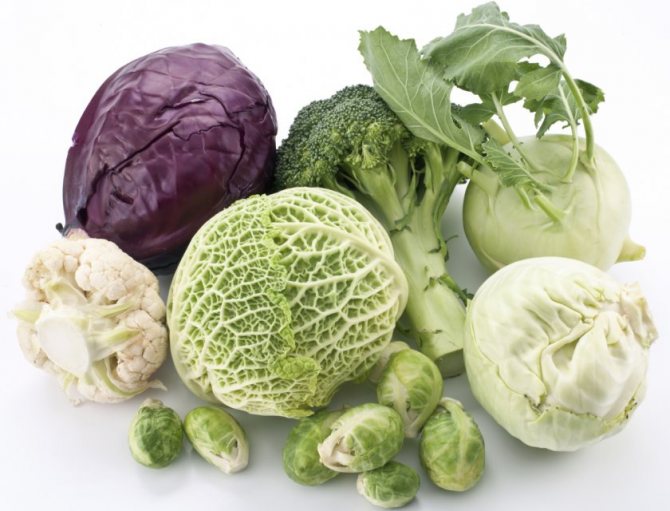
They are all necessary for tissue repair. Vitamin U is an irreplaceable element. It is not produced by internal organs and can only be obtained through food. To obtain juice, sauerkraut is placed in a colander, crushed, squeezed and mixed with the drained brine. Fresh leaves are cut into small pieces and also ground in a meat grinder.
The resulting drink is heated in a steam bath to 60 degrees, this increases its usefulness. You should drink it warm, about 30 - 35 degrees, before eating. The dosage and duration of administration are determined by the doctor. For the purpose of prevention, juice is consumed 300 - 400 ml 3 times a day for a month.
White cabbage casserole
The fiber in fresh cabbage injures a sore stomach. For ulcers and gastritis, it should be processed. You can ferment, stew, boil, bake. During the period of remission, it is advisable to eat the vegetable every day as a side dish for meat and potatoes. You can add cabbage to porridges, increasing their value and diversifying your diet.
As you recover, you can add peeled zucchini, pumpkin, apples, cherries, mushrooms, green onions and other products to the vegetable. Eating new dishes with meat and fish should be done on fasting days, returning to foods from a gentle diet. Cabbage casseroles with mushrooms, apples, cottage cheese contain a large amount of useful substances, activate the stomach and restore strength.
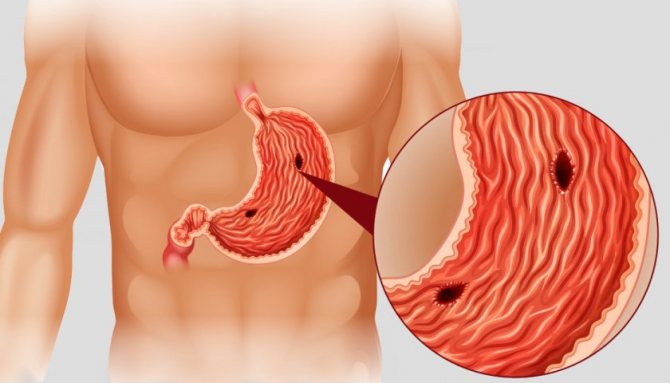
Cauliflower for stomach ulcers
In cauliflower, the fiber is softer and easier to process. The protein content of various compounds is higher. It inhibits the development of cancer cells, is an antioxidant, a strong antitumor agent, and is used in the prevention of cancer, including the gastrointestinal tract. The inflorescences can be stewed on their own or with other vegetables, fish and meat.
Broccoli is a type of cauliflower, has a soft structure, and is high in vitamins P and B. It is especially useful for older people. Restores the functioning of the stomach and intestines, heals wounds and relieves inflammation.
Broccoli is softer and contains less fiber. You can make salads from it. For those suffering from stomach ulcers, raw vegetables are contraindicated, only boiled or stewed. In addition to regular products, broccoli can be cooked with cottage cheese, cheese, and cream. When baking, pour in the egg beaten with milk and butter.
Sea kale for gastritis
Chinese cabbage is soft and is usually used fresh for making salads. It is healthy, contains the entire list of microelements and vitamins, including U, soft fiber. If the disease worsens, Chinese cabbage should be excluded from the diet. As the body recovers, it can be stewed or added to soup.

Seaweed is named for its similar taste and is cut into the same thin noodles as white cabbage. It contains a lot of iodine and zinc. The plant promotes rapid healing of wounds and restores immunity. During remission, kelp is added in powder form to various dishes. When the stomach disease worsens, it increases acidity.
You can use cabbage for gastritis with low or high acidity
A disease such as gastritis is directly related to nutrition. Accordingly, there are recommended and strictly prohibited products that can cause an acute reaction. In this regard, let’s figure out whether cabbage, a healthy but rough vegetable for the stomach, is ok for gastritis.
What is gastritis of the stomach
Gastritis is inflammation of the gastric mucosa. There are several types: with normal acidity, with increased, decreased or no acidity at all: this condition is called achylia. With gastritis, the stomach glands that produce acid undergo atrophy and are replaced by connective tissue. Therefore, such gastritis is often called atrophic.
According to the course, acute and chronic gastritis are distinguished. Acute can be caused by eating large amounts of fatty or spicy foods, drinking alcohol, or taking certain medications. And also when infected with pathogenic microorganisms or their toxins.
Chronic gastritis can arise from acute gastritis if the rules of its treatment are not followed, or it can develop independently. The main symptoms are epigastric pain of varying intensity, heartburn, belching, and bowel dysfunction.
With prolonged untreated gastritis, there may be weight loss, dizziness, weakness, and vitamin deficiency.
Causes of gastritis
There are several causes of chronic gastritis.
- Hereditary predisposition.
- Helicobacter pylori infection.
- Violation of nutrition and diet: long breaks in eating, eating large amounts of fatty, spicy, fried foods, seasonings.
- Having bad habits: smoking, and on an empty stomach. Abuse of alcohol, strong tea, coffee.
- Allergies to a number of foods.
- Reaction to certain medications: glucocorticoids in tablets, non-steroidal anti-inflammatory drugs, cardiac glycosides.
- Duodeno-gastric reflux.
- Working with occupational hazards – salts of heavy metals, toxic fumes.
- Decreased production of mucus by stomach cells.
- The presence of chronic infections - syphilis, tuberculosis.
- Prolonged stress.
- Avitaminosis.
- Autoimmune processes leading to damage to the mucosa.
- Other diseases of the digestive system.
Therapy includes many points. And the main one is the normalization of diet and nutrition.
You should eat often in small portions (fractional meals). Fried, salty, sour, spicy, sauces, and spices should be excluded from the diet. And also carbonated drinks, fast food, alcohol, strong tea and coffee.
Is it possible to eat cabbage with gastritis and what kind?
Many foods for chronic gastritis are consumed solely depending on their acidity. Cabbage is one of these.
Fresh white cabbage has a number of undeniable advantages.
- Contains many vitamins and microelements.
- Stimulates the production of hydrochloric acid.
- Accelerates metabolism and the healing process.
- Strengthens the vascular wall.
- Increases intestinal motility.
- Relieves inflammation and has an analgesic effect.
But cabbage contains a large amount of coarse fiber, which will increase irritation of the mucous membrane and increase pain. Therefore, it is better to consume juice rather than whole cabbage. And use it only with low or zero acidity!
In this case, you must adhere to some rules:
- The juice should only be freshly squeezed - storage in it destroys the beneficial substances.
- It should be slightly warm.
- Take half a glass three times a day an hour before meals.
- The juice should not be salted or spices added to it. You can mix it with water or other juice - apple, potato.
- Contraindicated for flatulence.
Is it possible to have stewed cabbage for gastritis?
Stewed and boiled white cabbage after heat treatment retains its properties: it is well digested, promotes tissue regeneration, and does not injure the mucous membrane. Plus, it's delicious and goes well with other dishes.
Used as a main dish and as side dishes. Indicated for low acidity of gastric juice.
Sauerkraut for gastritis
It is used mainly for hypacid or anacid gastritis, as it stimulates the production of hydrochloric acid. In addition, it normalizes the intestinal microflora and increases its peristalsis, strengthens the immune system and promotes epithelial regeneration.
Before use, it is recommended to grind it to a homogeneous consistency.
Sea kale
It is an ordinary seaweed, rich in vitamins and microelements (about 40). Improves metabolism, is well absorbed, saturates in small quantities. It also enhances peristalsis and stimulates the production of hydrochloric acid.
Therefore, it is not recommended for hyperacid gastritis and a tendency to loose stools (laxative effect). Used both independently and as an additive to salads. Besides this, it is very tasty.
Cauliflower for gastritis
A very healthy vegetable with a delicate texture when boiled. Does not injure the mucous membrane, contains methylmethionine, which has an antibacterial effect and promotes healing. It contains much more useful substances than other types.
In addition, it promotes the production of hydrochloric acid, so it is used only in cases of low or zero acidity. It is used in the form of juice (rarely) and in the form of boiled, baked, steamed.
Contains a large amount of fiber, so it is not recommended in large quantities. If gastritis worsens, you should refrain from eating cabbage.
Is it possible to have Chinese cabbage?
Chinese cabbage, beloved by many, also contains a large amount of fiber: and this is a serious irritation of the already injured mucous membrane. But it has a lot of useful qualities: it contains a lot of vitamins and microelements, improves immunity, in the east it is considered a factor of longevity.
Contains citric acid, which increases secretion, therefore it is indicated for low or zero acidity. It is used in cooked form - stewed, boiled and as an additive to dishes.
Broccoli for gastritis
Broccoli can also be used for gastritis. This cabbage is rich in vitamins (lots of vitamin C) and microelements (champion in magnesium content), strengthens the vascular wall and contains oxidants.
Intoxic is an anthelmintic that safely removes parasites from the body. Intoxic is better than antibiotics because: 1. It kills parasites in a short time and gently removes them from the body. 2. Does not cause side effects, restores organs and reliably protects the body. 3. Has a number of medical recommendations as a safe remedy.
4. Has a completely natural composition.
Source: https://nebolitzhivot.ru/gastrite-kapusta.html
Is it possible to eat cabbage if you have a stomach ulcer?
A stomach ulcer is a dangerous disease of the organ, characterized by the appearance of fresh wounds that do not heal for a long time on the gastric mucosa. The main cause of the pathology is excessive production of hydrochloric acid, which strengthens the wound surface. This problem requires immediate treatment, since, if delayed, peptic ulcer disease can cause complications in the form of cancer and bleeding into the abdominal cavity.
An important part of the treatment is the diet, which must be followed impeccably throughout the entire treatment process and after. The diet is based on warm dishes and bland foods that are easily digestible and digestible by the stomach.
The vegetable contains a lot of fiber, which when fresh is difficult to digest and can negatively affect the lining of the stomach. In addition, the product can increase the formation of acid in the stomach and provoke bleeding, so the use of the vegetable during the acute stage of the pathological process is strictly prohibited.
Marine
Did you know? In fact, cabbage is a huge bud, and its stalk serves as a stem.
The benefits of pumpkin for gastrointestinal diseases
One of the necessary products to consume is pumpkin and the drink obtained from this vegetable. Fresh pumpkin has a small amount of hard-to-digest fiber, so it is easily digested, leaving many useful substances in the body.
Due to its structure, pumpkin envelops the walls of the organ, promoting rapid healing of wounds and improving food digestion processes. The product's tannins help reduce the body's production of hydrochloric acid in the gastrointestinal tract.
We recommend reading: Hemoglobin in children
The pumpkin drink should be taken during meals or after eating. The product is drunk in small portions several times a day. The advantage of this drink over other vegetable drinks is that it tastes good and is easy to drink.
Pumpkin helps not only the stomach, but also the intestines. After regular consumption of the vegetable, intestinal function improves and the bowel movement returns to normal. It is possible to enhance the positive effect by mixing it with carrot juice.
Marine
Many gastroenterologists are inclined to believe that conservative treatment of gastric ulcer disease will be much more productive if seaweed is added to the ulcer patient’s diet, because it contains a huge amount of zinc. But during acute conditions, it is better to avoid using this product. Why.
- Sea kale increases acidity, which is not useful for any stomach pathologies;
- In addition, it swells in the stomach cavity, which creates additional stress on the walls of the stomach.
Some doctors recommend using kelp powder, but first consult a gastroenterologist.
Is it possible to have stewed cabbage if you have a stomach ulcer?
White cabbage, steamed, stewed or boiled, does not provoke hyperacidity so much, however, it enhances the secreting gastric functions, so in case of exacerbations and in this form, white cabbage should be excluded from the menu completely.
If the ulcer does not bother you at all and is in a stage of long-term remission, then you can include stewed white cabbage as part of a vegetable stew or as a side dish for mashed potatoes or boiled veal.
Many people know about the beneficial properties of cabbage in the case of various diseases of the gastrointestinal tract. Stomach ulcers are no exception. It is not surprising that cabbage is present in many folk recipes for this disease. But will cabbage always be healthy, and is it ok to have stewed cabbage if you have a stomach ulcer? Here you need to pay special attention to the opinion of doctors.
So, cabbage, in fact, in some cases may well act as one of the components of dietary nutrition. This is explained by the component present in it, under the influence of which an acceleration of the healing process of the mucous membrane is noted. But if we consider periods of exacerbation, then in this case cabbage will not only not be useful, but will also significantly slow down the entire healing process as a whole.
We invite you to familiarize yourself with Instant Cabbage with Vinegar and Oil
But is it possible to have stewed cabbage if you have a stomach ulcer? It is in this form that cabbage is allowed on the menu for patients, but only outside of exacerbations. In addition, boiled cabbage is also allowed.
The fact is that, unlike raw cabbage leaves, cauliflower, white cabbage and broccoli, stewed or boiled, do not significantly increase acidity. But even stewed cabbage can significantly increase secretion in the stomach. This is precisely why doctors explain the unequivocal ban on cabbage in all forms during an exacerbation of an ulcer.
As soon as the disease gradually goes into remission and ceases to cause anxiety to the patient, you can gradually add a dish such as stewed cabbage to the menu. At the same time, it can not only be eaten as part of a vegetable stew, but also as an independent side dish, especially with lean boiled beef.
Unlike white cabbage, it is most preferable to use cauliflower for stomach ulcers. After all, it is characterized by a fine cellular structure and the content of a small amount of coarse fiber against the background of the presence of a large number of various protein compounds. Due to these factors, such cabbage is perceived much better by an inflamed stomach, without irritating its injured mucous membrane.
Broccoli, as one of the varieties of cauliflower, is also allowed to be consumed for stomach ulcers. Steamed, stewed or boiled broccoli can be eaten as an independent dish or in puree soups. Moreover, some experts believe that broccoli for stomach ulcers can be a complete replacement for white cabbage, which is completely excluded from the menu during such illnesses in some periods.
Properties of cabbage juice
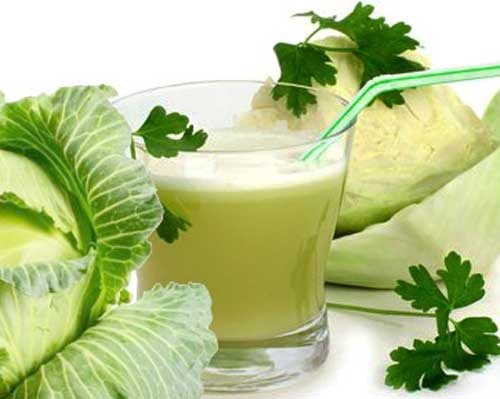
Main advantages:
- improves the condition of skin, nails, hair;
- cleanses the intestines;
- reduces inflammation;
- regulates stomach acidity;
- strengthens the local immune system in the fight against gastritis and ulcers;
- accelerates the regeneration of tissues and cells;
- relieves constipation.
This traditional medicine is recommended for the prevention of gastrointestinal diseases. It is able to normalize the functioning of the digestive system and speed up the process of getting rid of ulcers. Self-prescription of this type of therapy is not allowed; it can be used only after appropriate diagnosis and doctor’s approval. Taken alone or with the addition of carrot juice in equal proportions.
Use for ulcers
To prepare the juice, only fresh leaves of the vegetable are taken. If there is rot, blackening or other damage to the product, the head of cabbage is not taken. Drink immediately after spinning. It is not recommended to take juice that has stood for more than 30 minutes. Initially, the cabbage is washed well under running water, cut and passed through a juicer. Drink 150 ml 2 times a day half an hour before meals.
The duration of treatment depends on the individual characteristics of the disease and averages 30-45 days. It can be mixed with potato juice in equal proportions, with the same dosage regimen, but taking into account that the first time it is drunk on an empty stomach before breakfast. You need to drink juice slightly warmed to room temperature. The use of cold cabbage drink is not allowed.
Colored
Gastroenterologists recommend switching from white cabbage to cauliflower for gastric ulcers.
- This type of vegetable crop is distinguished by the presence of lighter fiber and protein components, which are very easily absorbed, easier to process and digest, and do not irritate the gastric mucous membranes.
- Therefore, cauliflower is often included in the diet of ulcer patients, using its antitumor properties to prevent cancer pathologies.
- Juice is also prepared from cauliflower, which is recommended to be taken on an empty stomach, ½ cup.
- Stewed and boiled dishes are also prepared from cauliflower inflorescences.
With daily consumption of vegetables, patients minimize the risk of developing cancer in the prostate, mammary gland, stomach, etc.
White cabbage
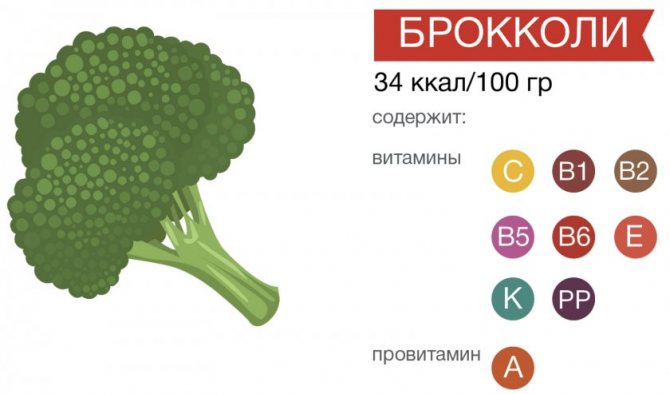
Those suffering from ulcers should learn that, despite the obvious benefits of white cabbage, in case of acute diseases of the stomach it is extremely undesirable to eat it fresh, especially with peptic ulcer disease.
It is allowed to consume a small amount of this type of cabbage during stable remission and only after heat treatment, for example, stewed, baked or boiled.
But gastroenterologists recommend drinking juice from white cabbage to their patients, because such a drink has a very beneficial effect on the stomach, since its fiber content is minimal.
Treatment of stomach ulcers with effective folk remedies
05/24/2020 · : · Reading time: 8 min · Views: Post Views: 360
A stomach ulcer is a serious and fairly common disease, accompanied by severe stomach pain, heartburn, and intestinal dysfunction.
However, with timely treatment of the disease, in many cases complete recovery occurs.
In this article we will look at the treatment of stomach ulcers with folk remedies, the most effective, proven recipes that have restored health to thousands of people.
Proper dietary nutrition, drug therapy and proven folk remedies will help to permanently cure stomach ulcers at home and prevent the development of complications.
Tomatoes for peptic ulcers
Tomato juice for stomach ulcers is recommended for patients with concomitant metabolic disorders, as well as those with a disease such as obesity. A person who regularly takes tomato juice reduces the risk of stomach and colon cancer.
It should be noted that any fresh juice is most useful in the first 10–15 minutes after its preparation, when it contains the maximum amount of vitamins and beneficial microelements. Therefore, it must be prepared before direct consumption.
The exception is breakfast - it is not recommended to drink any juice on an empty stomach, as it will increase the acidity of gastric juice and contribute to the appearance of pain, and with prolonged use it contributes to the recurrence of stomach ulcers.
Contraindications
So, any fresh cabbage is contraindicated for people with ulcers if they are experiencing an exacerbation of gastric pathology. Moreover, the contraindication applies to broccoli, cauliflower, and other varieties of vegetables.
Fresh white cabbage is contraindicated for pathologies such as:
- Exacerbation of ulcerative pathology of the duodenum or stomach;
- For thyroid pathologies;
- For bleeding in the gastrointestinal tract structures;
- For acute enterocolitis with diarrhea.

As for cabbage juice, it is contraindicated in case of hyperacid nature of gastric secretions, because the drink provokes active stimulation of the secretory functions of the stomach.
Cabbage is useful for patients due to the presence of vitamin U in its composition, which has pronounced anti-ulcer properties and accelerates the regeneration of damaged areas of the mucosa. You just need to follow the rules for consuming this vegetable, exclude it during periods of exacerbation, then the vegetable will be exclusively beneficial.
The vegetable should not be consumed during exacerbation of enterocolitis, which is accompanied by diarrhea and vomiting. The appearance of bleeding ulcers in the stomach is also a contraindication. Despite the numerous beneficial properties of cabbage, it can only be consumed during the period of remission of a peptic ulcer. In this case, the treatment and diet menu should be drawn up by the attending physician.
Was this article helpful?
Thank you for your opinion!
Write in the comments what questions you have not received an answer to, we will definitely respond!
You can recommend this article to your friends!
You can recommend this article to your friends!
Yes
No
Tomato juice
Many patients with stomach ulcers wonder: can they drink tomato juice at all? There is no definite answer to it, and here’s why: juice can either significantly alleviate the patient’s condition or cause irreparable harm. It all depends on a number of reasons.
If you have a peptic ulcer, never drink store-bought juices. They contain a huge amount of chemicals or salt, which is completely unacceptable in your case. For stomach and duodenal ulcers (only during remission!), you can drink freshly squeezed tomato juice, which, if necessary, should be diluted with boiled water.
If you want to drink tomato juice all year round, you can preserve it for the winter. Pass fully ripened tomatoes, without rot or other defects, through a juicer, pour the resulting juice into an enamel pan, bring to a boil and simmer over low heat for 20 minutes. Pour hot into clean, sterilized jars and seal with tin lids. A drink prepared in this way almost does not lose its beneficial qualities, is perfectly stored and, unlike store-bought drinks, does not contain preservatives.
You should not drink tomato juice on an empty stomach. But after lunch it will come in handy. Just don’t add salt to it: it’s harmful for peptic ulcers. In addition, the juice from the freshest homemade tomatoes of the best tomato varieties (Bull's Heart, Premiere and others) is so tasty and individual that salt will only spoil it.
The benefit of tomato juice is that it contains vitamins A, B, C, E and PP, as well as calcium, magnesium, potassium, phosphorus, zinc and other mineral compounds. Thus, this healthy and very tasty drink helps to effectively remove toxic substances from the body and get rid of vitamin deficiency, which often accompanies ulcers.
However, during an exacerbation it is better not to drink it: the acids it contains will cause additional irritation and lead to increased pain.
In addition, tomato juice should not be consumed by people suffering from gastritis, pancreatitis or cholecystitis. Before starting treatment with tomato juice, be sure to consult with your doctor or carefully study your medical card for the diseases described.
Broccoli
Broccoli cabbage is no less useful for ulcers.
- It can be eaten boiled, stewed, baked or steamed, or juice can be made from broccoli.
- Only heat-treated cabbage is suitable for consumption by ulcer patients, because in its raw form it provokes hypersecretion of hydrochloric acid secretion, which causes heartburn and deterioration of the patient’s condition.
- For prevention purposes, it is useful to drink broccoli juice or dishes prepared from the shoots, because this type of kaputa is rich in sulforaphane, a natural antibiotic that inhibits the development of disease-causing pathogens, including Helicobacter.
In general, broccoli can be a complete replacement for white cabbage, which is strictly forbidden to eat during exacerbations.
Beijing
Chinese cabbage is soft and is usually used fresh for making salads, but it should still be excluded from the diet if gastric ulcers worsen.
When the exacerbation gradually subsides, you can add it little by little to soups. Fresh Chinese cabbage can only be eaten by people with an absolutely healthy gastrointestinal tract.
Chinese cabbage juice is beneficial and is even taken as a supplement to drug therapy. The dosage and duration of use are determined by a gastroenterologist.

